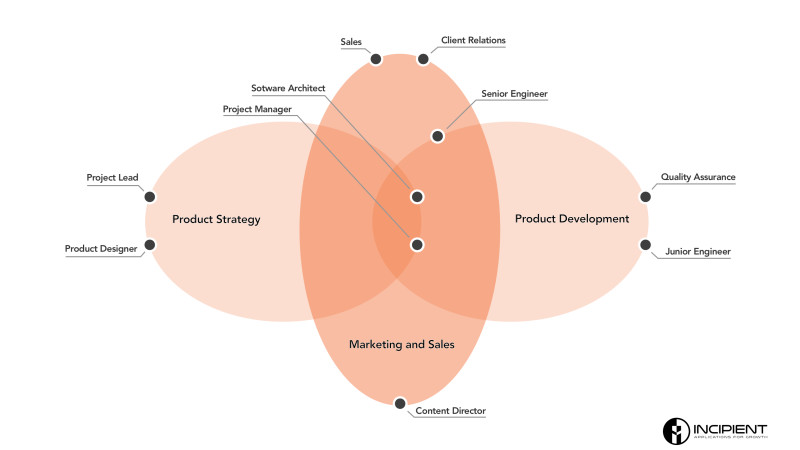How Incipient Used a Transparent Circular Structure to Triple in Two Years
About two and a half years ago, Bryan Weinert realized he had a growth problem.

About two and a half years ago, Bryan Weinert realized he had a growth problem. The Project Managers at Incipient Corp, the New Jersey-based software consulting firm where Weinert is Partner & COO, couldn’t lead more than three projects at a time. No matter how talented the PM or how strenuous the project was on developers, the current structure was creating a clear limit on their capacity to take on more projects.
Weinert did some digging and realized his PMs were being trapped by a central flaw in the traditional hierarchical structure — they were accountable for every detail of their projects, top to bottom. Engineers who hadn’t been given visibility into the larger project specs were completely dependent on the direction of their PMs, unable to provide input into execution or approach. Hence the cap on production. By being involved in every single step of the process, teams were working themselves into silos. They needed a more efficient way to allocate their time and increase the impact of their decisions.
So for three months, Weinert and Incipient Partner & CEO Amit Shah sat down and sketched out a new structure for the organization with a focus on empowering their employees to create a better overall sense of cohesion. Eventually the two came up with a graphic of a circular team structure. Weinert then went around to every employee at the company with this graphic and made adjustments after hearing their input, then implemented the new company-wide circular structure.
That was in 2018, when Incipient had around 20 employees. Two years later, they’ve almost tripled the size of the team. Incipient has been able to work with more than 100 clients at a time in 2020 in large part because open communication channels have allowed its PM’s to go from working on three projects at a time to being able to handle almost ten.
“We still use the exact same circular format and we’re confident that’s what has led to much of our success right now,” Weinert said. “Within the software industry, it’s fun and dynamic, but every project brings its own complexities. You can't have one person at the top making all the decisions without the proper inputs and clear facts from those they are managing.
"There are all these factors coming into to play at the same time and you want to empower everyone in the organization to bring their own voices and talents to the project.”

Weinert published a great blog on the concept at the time, as the structure is a little complicated to the outside eye. Essentially, every project has a PM and a head engineer. Instead of sitting at the top like in a hierarchy, sending information and requests down the chain of command, they sit in the middle of three pods — Product Strategy, Product Development, and Marketing & Sales. Those pods include several different members of each of those teams, all of whom are empowered to report to their project leads.
This forces information to be pushed from the bottom up, not requested from the top down. The decentralized system encourages objective opinions and empowers employees to make product decisions, greatly speeding up production of the kind of creative, interesting work that keeps a software consulting firm in business.
“We’ve worked on projects we never could have without these synergies and it’s been vital to our growth,” Weinert said. “Most founders think you can’t build a culture or structure until they’re big. That’s why startups don’t make it. Everything is transactional and siloed or outsourced. But if you build a sense of community and synergy, everyone gets involved and the momentum becomes contagious.”
There are other interesting tweaks, too. One day every two weeks, engineers have to take a day off their own project to work on someone else’s. Sometimes they force hackathons on each other, building a piece of a product where they only know the end goal of the project and not the client requests. According to Weinert, this specific creativity has led to contracts with much bigger clients requesting more interesting, inspired work.
These realizations led Weinert to publish the blog on the advantages of the circular structure. Rather than making a big change and holding those findings internally, he realized that Incipient’s transformation was led by constantly driving different perspectives from a more objective structure. Being transparent about that growth would lead to more perspectives, which ultimately, was sort of the point in the first place.
“When we started 10 years ago, every company worked on their own niche to show they could create their whole product internally,” Weinert said. “Even if they couldn’t, they would white label their partners. Fortunately for all of us, tech is emerging as more of a partnership community, because at the end of the day, everything comes down to execution.
“I didn’t think we were giving a competitive advantage away by explaining what we felt was the best way to execute and what worked for us. We’ve had friends help us with tools, we help with tools, and putting this out there helps everyone.”
--
The Org is a professional community where transparent companies can show off their team to the world. Join your company here to add yourself to the org chart!
In this article


The ORG helps
you hire great
candidates
Free to use – try today
